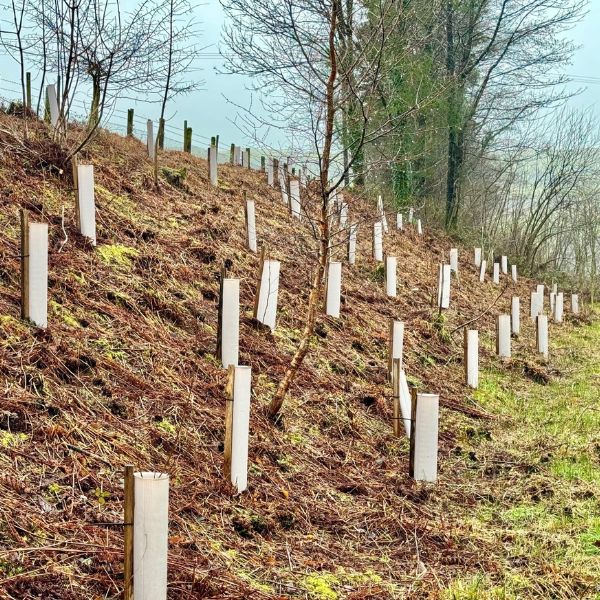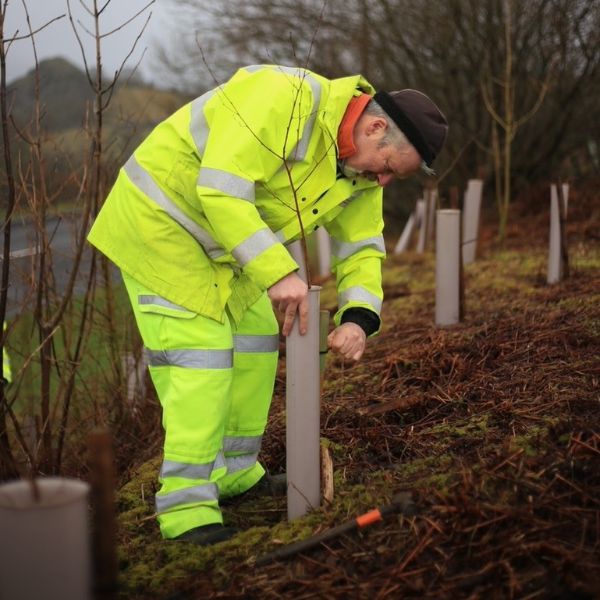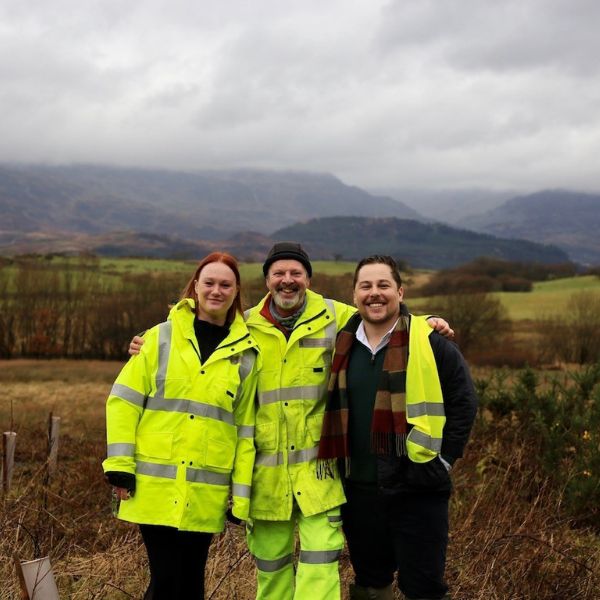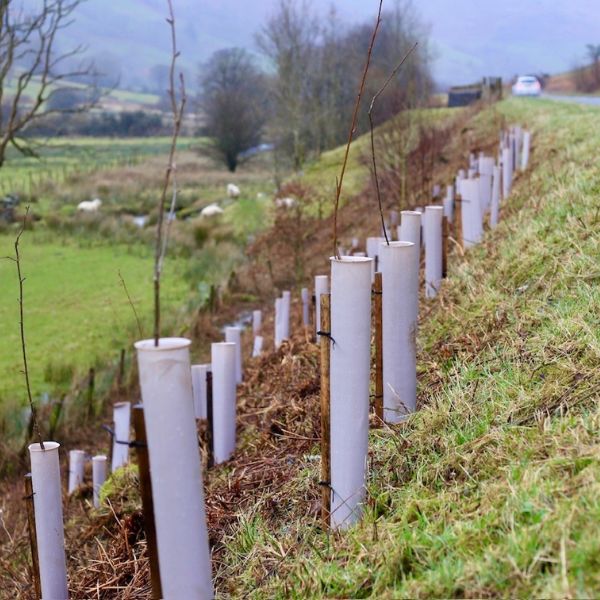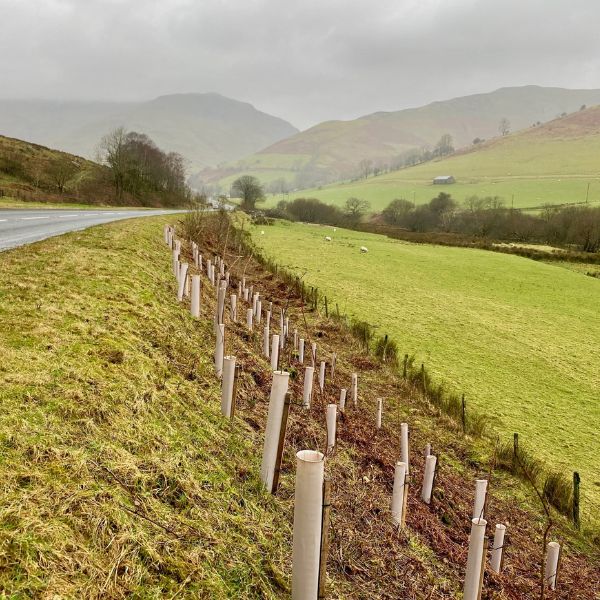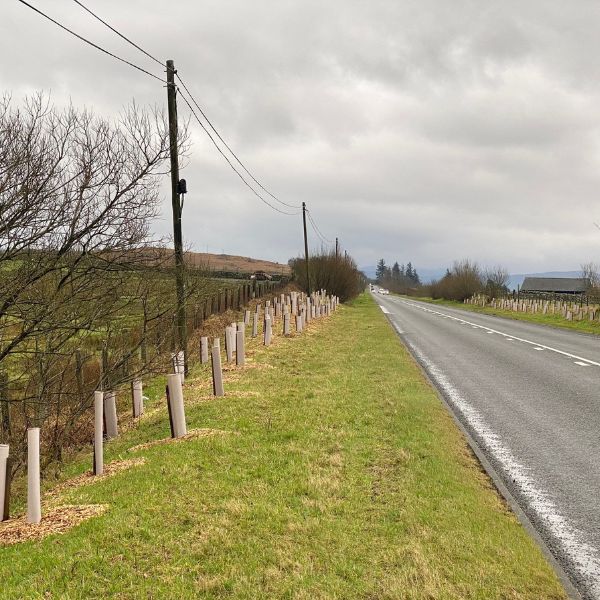Driving towards sustainable highways: Connecting habitats through roadside tree planting
The Vigilis Tree Shelters team had the opportunity to visit one of our valued forestry customers in the heart of North Wales earlier this month. It may have been raining on our visit, but that didn’t dampen our spirits! Nestled amidst rolling hills and Welsh valleys, we witnessed first-hand Bob and Frances’ dedication and passion when it comes to managing the verges on Welsh trunk roads and highways.
Bob and Frances from North and Mid Wales Trunk Road Agents (NMWTRA) shared their big plans, discussed the importance of maintaining verges and the soft estate along the highways and gave us a guided tour. We were delighted to see our Vigilis-Bio (soil biodegradable & plastic-free) tree shelters performing well – they have stood up to the Welsh weather and provided vital protection to native birch, hazel and hawthorn saplings over the last couple of years.
As part of the North and Mid Wales Trunk Road Agents (NMWTRA) team, Bob and Frances look after the verges on over 1000km of trunk road, with a focus on improving biodiversity and increasing the presence of native species. They are working hard to create habitat highways/corridors to enable wildlife to roam freely.
We asked them a few questions whilst travelling between planting sites….
How do you manage the verges across the trunk roads?
To look after the verges, we:
– Manage vegetation to improve wildlife habitats; or protect historic features. We arrange for the vegetation, such as grass, to be cut in spring and summer so that road users can see better and have a safe space away from the road. But we ensure that we don’t cut them during the flowering season for native wildflowers, whenever possible.
– Connect woodland, hedgerows and grasslands so that animals have safe spaces to live, hibernate and move from one place to another.
– Inspect and manage trees and shrubs to make sure they won’t fall down and are not diseased.
– Protect our native wildlife and plants from invasive species and manage harmful diseases like ash dieback.
– Plant trees and shrubs in autumn and winter.
– Install animal crossing points like bridges and culverts so that animals can cross roads safely.
Are road verges good habitats?
Yes, road verges provide a great habitat for wildlife because they aren’t usually disturbed by people. They are brilliant for connecting habitats together, increasing biodiversity and providing a home to some rare species.
– Woodlands, native trees and shrubs provide food, nesting/roosting sites and shelter for birds, bats and dormice.
– Heathlands provide a habitat for a range of birds, reptiles and invertebrates.
– Flower-rich grasslands support a range of native wildflowers, like the oxeye daisy, and provide valuable habitat and food sources for pollinators and other invertebrates.
– Rocky areas and scree faces are good for lichens and moss, and even some reptiles.
We monitor the land we own all year round to find areas that are important for wildlife. During the summer months, we carry out extensive surveys to check the geometry of the plots, and the species present on our verges. This also gives us the opportunity to come up with recommendations for work to be carried to improve the biodiversity of the verges.
Why do we need ‘green corridors’ on our road networks?
– Planting and maintaining the green corridors along our highways improves the quality of the landscape and protects important plant and animal species.
– Improves connectivity between habitats.
– Create spaces for wildlife, including dormice, bats, owls, newts, birds and more.
– Helps to combat the effects of climate change.
– Planting native trees along our roads is a natural way to store carbon.
– They help to create floodplains and sustainable drainage.
Are there any barriers or issues you’ve faced with planting?
There is often not enough space on the narrower areas of soft estate (green areas between the road and boundary of neighbouring land) for tree planting as there needs to be a minimum clearance between roads and trees to prevent visibility obstruction for drivers. We are considering other options such as hedging or planting wildflowers in these areas. Occasionally, we find a site that seems perfect for planting but there can be other restrictions such as road signage which means it is unsuitable to plant trees in these areas.
In areas where we can plant trees, it’s imperative to use tree shelters as this not only prevents browsing animals from eating the saplings but it also prevents maintenance teams from mowing or strimming the newly planted trees.
Public perception/education is important – we are trying to increase the abundance of native species, however, some residents can be keen to plant non-native species or do not understand why we are cutting some trees down. Ash dieback or unsafe trees that pose a danger to drivers are the main reasons for felling and replanting. It is important to educate the public so they can understand the important work that we are doing.
Tell us about an interesting project you’ve worked on recently.
It involves the rare Lesser Horseshoe Bat. These bats often fly along linear features such as tree and hedge lines, so when there are gaps in the trees, they will drop down and fly along and often across the road. Therefore they will be susceptible to being hit by vehicles on the busy trunk roads. By installing a bridge-like structure across the road, which is in line with the tree canopy, as well as suitable culverts under the roads we have been able to create safer crossing routes for the Lesser Horseshoe Bat.
What did we as a team take away from this visit?
The Vigilis Tree Shelters team thoroughly enjoyed learning about how Bob and Frances are creating habitat highways along the Welsh roads. We found it particularly interesting that they will plant native trees wherever they can. A lot of people want to focus on big plantations, however, they will happily plant a handful of trees in an area along a highway if it’s possible because every tree counts!
Bob and Frances have got lots of exciting plans and projects in the pipeline and it’s a privilege to continue to work with them.
NOTES:
North and Mid Wales Trunk Road Agents (NMWTRA) are responsible for managing, maintaining and improving the strategic road network in North and Mid Wales on behalf of the Welsh government. NMWTRA operates on the basis of a partnership between the 8 North and Mid Wales local authorities.

